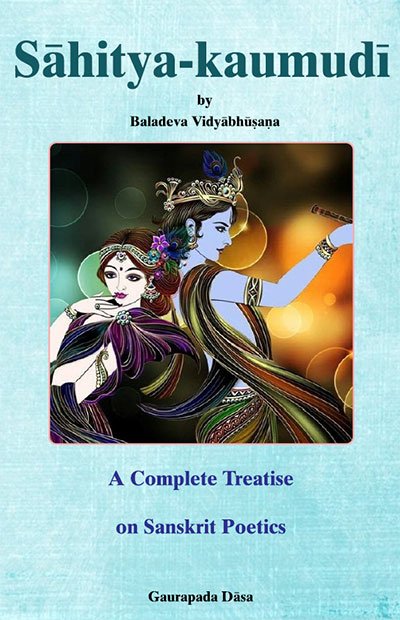Sahitya-kaumudi by Baladeva Vidyabhushana
by Gaurapada Dāsa | 2015 | 234,703 words
Baladeva Vidyabhusana’s Sahitya-kaumudi covers all aspects of poetical theory except the topic of dramaturgy. All the definitions of poetical concepts are taken from Mammata’s Kavya-prakasha, the most authoritative work on Sanskrit poetical rhetoric. Baladeva Vidyabhushana added the eleventh chapter, where he expounds additional ornaments from Visv...
Text 10.58
[This verse exemplifies a serial paramparita not based on paronomasia:]
दारिद्र्य-गज-पञ्चास्यो दुर्नयाम्बुधि-मन्दरः ।
दानवारण्य-दावाग्निर् दुःखं दामोदरो द्यतु ॥
dāridrya-gaja-pañcāsyo durnayāmbudhi-mandaraḥ |
dānavāraṇya-dāvāgnir duḥkhaṃ dāmodaro dyatu ||
dāridrya—of poverty; gaja—for the elephant; pañca-āsyaḥ—Śiva (“he has five faces”); durnaya—of bad conduct; ambudhi—for the ocean; mandaraḥ—the Mandara Mountain; dānava—of demons; araṇya—of the forest; dāvāgniḥ—of the conflagration; duḥkham—the sorrow; dāmodaraḥ—Dāmodara; dyatu—may He tear to pieces.
He is Śiva for the elephant of poverty, and the Mandara Mountain for the ocean of bad behavior. May He, Dāmodara, terminate the sorrow which is the conflagration of the forest of Dānavas.
atra dāridryāder bhinna-śabda-vācyasya gajatvādy-āropo dāmodarasya pañcāsyatvādy-ārope hetuḥ. iha hetu-phalayor vaiparītyaṃ kecid vyacakṣate. tad evam aṣṭau rūpaka-bhedāḥ.
In this verse, the superimpositions of an elephant unto poverty and of an ocean unto bad behavior are the causes of superimposing “being Śiva” unto Dāmodara and “being Mandara Mountain” unto Him. Here the terms are not paronomastic. In paramparita, some persons see reverseness between the cause and the result (Commentary 10.57).
The eight varieties of rūpaka occur in this way.
Commentary:
The reverseness of the causal relation can also be interpreted in the nonparonomastic paramparita. For example, in “The moon of Your fame makes the Dānava lotuses close” (10.56), it could be said that the metaphor “the moon in the form of fame” justifies the metaphor “lotuses in the form of Dānavas.” The reverseness does not always apply. Paṇḍita-rāja Jagannātha gives examples of paramparita metaphors based on reverse causation (the subject of description is part of a metaphor which is the justifying cause of the other metaphor): (1) ānanda-mṛga-dāvāgniḥ śīla-śākhi-mada-dvipaḥ, jñāna-dīpa-māhā-vāyur ayaṃ khala-samāgamaḥ, “The arrival of miscreants is a forest conflagration for the deer of happiness, a mad elephant for the trees of good conduct, and a windstorm for the lamp of knowledge,” and (2) kāruṇya-kusumākāśaḥ śānti-śaitya-hutāśanaḥ, yaśaḥ-saurabhya-laśunaḥ piśunaḥ kena varṇyate, “He is the sky for the flower of compassion, fire for the coolness of peacefulness, and garlic for the fragrance of renown. By whom can a bad critic be described?” (Rasa-gaṅgādhara, KM p. 238)
